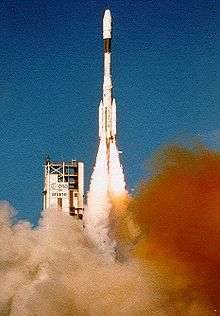Liquid rocket booster
A liquid rocket booster (LRB) is similar to a solid rocket booster (SRB) attached to the side of a rocket to give it extra lift at takeoff. A liquid rocket booster has fuel and oxidiser in liquid form, as opposed to a solid-fuel rocket or hybrid rocket.
By 1926, US scientist Robert Goddard had constructed and successfully tested the first rocket using liquid fuel. Indeed, the flight of Goddard’s rocket on March 16, 1926, at Auburn, Massachusetts, was as significant to history as that of the Wright brothers at Kitty Hawk.

Like solid boosters, liquid boosters can considerably increase the total payload to orbit. Unlike solid boosters, LRBs can be throttled down and are also capable of being shut down safely in an emergency, providing additional escape options for human spaceflight.
For the R-7 missile, which later evolved into the Soyuz rocket, this concept was chosen because it allows all of its many rocket engines to be ignited and checked for function with the rocket still on the launch pad.
The Soviet Energia rocket of the 1980s used four Zenit liquid fueled boosters to loft both the Shuttle Buran and the experimental Polyus space battlestation in two separate launches.
Two versions of the Japanese H-IIA space rocket would have used one or two LRBs to be able to carry extra cargo to higher geostationary orbits, but this plan was replaced by the H-IIB.
The Ariane 4 space launch vehicle also optionally could use two or four LRBs (the 42L, 44L, and 44LP configurations). As an example of the payload increase that boosters provide, the basic Ariane 40 model with no boosters could launch around 2,175 kilograms into Geostationary transfer orbit . The 44L configuration could launch 4,790 kg to the same orbit with four liquid boosters added .
Various LRBs were considered early in the Space shuttle development program and again after the Challenger accident, but the Shuttle continued flying its SRBs until retirement.
Pratt & Whitney Rocketdyne and Dynetics entered the "advanced booster competition" for NASA's next human rated vehicle, after the retirement of the Space Shuttle, the Space Launch System (SLS), with a booster design known as "Pyrios", which would use two F-1B engines derived from the F-1 LOX/RP-1 engine that powered the first stage of the Saturn V vehicle in the Apollo program. In 2012, it was determined that if the dual-engined Pyrios booster was selected for the SLS Block II, the payload could be 150 metric tons (t) to Low Earth Orbit, 20 t more than the congressional minimum requirement of 130 t to LEO for SLS Block II.[1] In 2013, it was reported that in comparison to the F-1 engine that it is derived from, the F-1B engine is to have improved efficiency, be more cost effective and have fewer engine parts.[2] Each F-1B is to produce 1,800,000 lbf (8.0 MN) of thrust at sea level, an increase over the 1,550,000 lbf (6.9 MN) of thrust of the initial F-1 engine.[3]
Common Core Booster
The Evolved Expendable Launch Vehicle program produced new liquid fueled primary stages for the Atlas V and the Delta IV rockets called Common Core Booster (CCB) or Common Booster Core (CBC). These can be used alone (with possible strap-on solid rocket boosters) or in a configuration of three CCBs tied together. The planned Falcon Heavy EELV originally planned to utilize the same arrangement, with three Falcon 9 or 9R cores connected together with a propellant cross-feed system to allow feeding all 3 cores from the booster fuel tanks, and saving fuel in the main core until booster separation, however development on the feature has been put on hold [4]and has since been removed from the SpaceX website. Instead SpaceX intends to throttle down the center core shortly after lift off to conserve fuel, and throttle the center core back up upon booster separation.[5]
See also
References
- ↑ "Dynetics PWR liquidize SLS booster competition". November 2012.
- ↑ "Dynetics reporting "outstanding" progress on F-1B rocket engine". Ars Technica. 2013-08-13. Retrieved 2013-08-13.
- ↑ Lee Hutchinson (2013-04-15). "New F-1B rocket engine upgrades Apollo-era design with 1.8M lbs of thrust". Ars Technica. Retrieved 2013-04-15.
- ↑ "Elon Musk on Twitter". Twitter. Retrieved 2016-06-07.
- ↑ spacexcmsadmin (2012-11-16). "Falcon Heavy". SpaceX. Retrieved 2016-06-07.